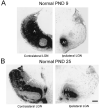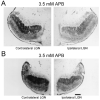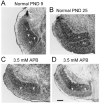Necessity for afferent activity to maintain eye-specific segregation in ferret lateral geniculate nucleus
- PMID: 10741966
- PMCID: PMC2637940
- DOI: 10.1126/science.287.5462.2479
Necessity for afferent activity to maintain eye-specific segregation in ferret lateral geniculate nucleus
Abstract
In the adult mammal, retinal ganglion cell axon arbors are restricted to eye-specific layers in the lateral geniculate nucleus. Blocking neuronal activity early in development prevents this segregation from occurring. To test whether activity is also required to maintain eye-specific segregation, ganglion cell activity was blocked after segregation was established. This caused desegregation, so that both eyes' axons became concentrated in lamina A, normally occupied only by contralateral afferents. These results show that an activity-dependent process is necessary for maintaining eye-specific segregation and suggest that activity-independent cues may favor lamina A as the target for arborization of afferents from both eyes.
Figures




References
Publication types
MeSH terms
Substances
Grants and funding
LinkOut - more resources
Full Text Sources

